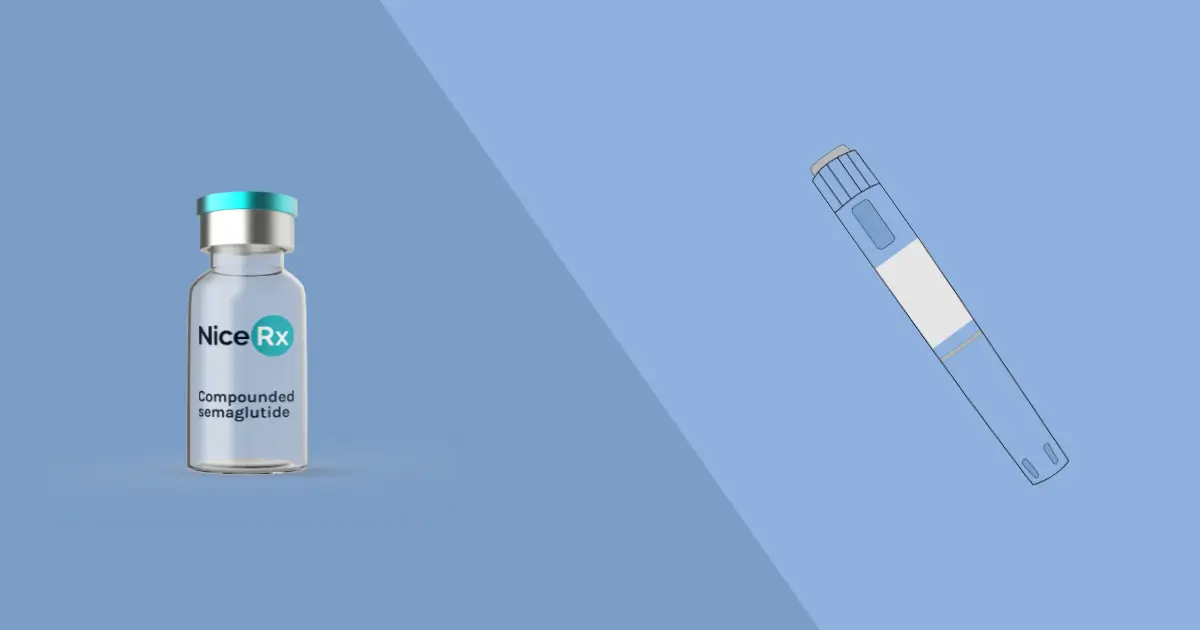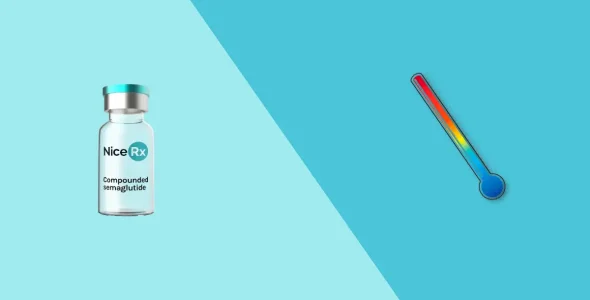Is compounded semaglutide the same as Ozempic?
Thinking about switching to compounded semaglutide? Discover the key differences from Ozempic before you make a decision.
Key highlights
- Ozempic and compounded semaglutide have the same active ingredient (semaglutide), mechanism of action, and side effects. Ozempic is an FDA-approved medication and compounded semaglutide is not.
- Compounded semaglutide comes with potential safety concerns, such as the risk of contamination, variations in quality, and incorrect dosing, while Ozempic has a higher safety profile.
- Compounded semaglutide is an affordable alternative to Ozempic to meet patients’ medical needs (such as allergies and custom dosing). It is easily accessible to patients during drug shortages.
- The effectiveness of compounded semaglutide may vary, depending on the quality standards of the compounding pharmacy.
- Always choose a U.S.-certified, reputable pharmacy or an outsourcing facility to purchase compounded semaglutide.
Semaglutide belongs to a class of GLP-1 medications that are growing in popularity due to their effectiveness in weight loss and blood sugar control. Manufactured by Novo Nordisk, the medication comes with three brand names: Ozempic, Wegovy, and Rybelsus. Wegovy is FDA-approved for chronic weight management, while Rybelsus and Ozempic are indicated for type 2 diabetes management when used in combination with exercise and a reduced-calorie diet.
Compounded semaglutide is a custom-made medication prepared by a compounding pharmacy or outsourced facility. It is made when the brand name drug is in shortage, or an individual needs a custom dosing or form that is not commercially available. Although the FDA does review compounded semaglutide for safety and effectiveness, many patients use it due to its low cost and easy availability.
A statistical analysis by the Outsourcing Facilities Association mentions that roughly 80 million prescriptions for compounded semaglutide were filled by compounding pharmacies in the last 12 months.
This article explores the similarities and differences between compounded semaglutide and Ozempic and guides you about safety and efficacy concerns.
What is compounded semaglutide?
Compounded semaglutide is a tailor-made medication that is prepared in a compounding pharmacy by a licensed pharmacist, healthcare provider, and people working under the direct supervision of licensed pharmacists. They mix, combine, and alter the ingredients of the medication to make a customized version of semaglutide.
Semaglutide is compounded to meet specific patient needs, such as allergies to certain ingredients of branded semaglutide, personalized dosing requirements, and to meet the need for medication during drug shortages. Although the FDA allowed compounding pharmacies to manufacture the medication under sections 503A and 503B during drug shortages, compounded medications are not FDA-approved or reviewed for safety and effectiveness.
Ozempic is an expensive medication. The list price for Ozempic from the manufacturer, Novo Nordisk, is $997.58. The average retail price supply can range from $1,000 to $1,300 per month, depending on the pharmacy you buy from. The high cost of Ozempic is challenging for many patients. In comparison, compounded semaglutide is available for $200-300 per month, which is affordable for many patients.
Cheaper does not mean the medication is safe. Compounded semaglutide comes with certain safety risks that you should be cautious about. Choosing a reputable compounding pharmacy or outsourced facility is critical to ensure the safety and quality of the medication.
What is Ozempic?
Manufactured by Novo Nordisk, Ozempic is a brand-name injectable medication with the active ingredient, semaglutide. The medication acts as a GLP-1 receptor agonist that binds and activates the GLP-1 receptor in the brain. GLP-1 agonists mimic the action of a natural hormone called glucagon-like peptide-1 in the body. GLP-1 is a hormone secreted by the body after food intake, and it regulates appetite and controls excess blood sugar levels. Research studies show that the active ingredient of Ozempic, semaglutide, has 94% structural similarity to the naturally occurring human GLP-1 hormone. This is why it can occupy GLP-1 receptors and mimic its action.
Ozempic works in the following ways:
- The medication restores the sensitivity of beta cells to increased blood sugar levels. This action increases insulin release from the beta cells of the pancreas. Enhanced insulin secretion lowers blood sugar levels.
- Ozempic relaxes stomach muscles and reduces motility, which delays the rate at which your stomach empties and the food moves into the intestine. The food stays in your stomach for a longer time, which means you experience fewer food cravings, and your hunger is suppressed.
A clinical study compared the effect of semaglutide injection on gastric emptying. The results demonstrate that semaglutide increased gastric retention by 3.5% after 1 hour, 25.5% after 2 hours, 38% after 3 hours, and 30% after 4 hours. Participants using semaglutide retained 37% of a solid meal after four hours compared to 0% retention in the placebo group.
- Glucagon is responsible for producing glucose in the liver, which increases blood glucose levels. Semaglutide (the active ingredient of Ozempic) reduces glucagon secretion from alpha cells of the pancreas, which lowers blood sugar levels.
- Ozempic affects the lateral hypothalamus of the brain, which is the hunger control center or feeling center. It suppresses appetite and reduces hunger pangs. Less food intake results in lower blood sugar levels.
When combined with exercise, increased physical activity, and dietary modifications, Ozempic is approved by the FDA (U.S. Food and Drug Administration) for:
- The treatment of type 2 diabetes
- Reducing the risk of major cardiovascular events, such as cardiovascular death, nonfatal stroke, and nonfatal myocardial infarction (heart attack) in adults with type 2 diabetes and existing cardiovascular disease
- Reducing the risk of worsening kidney disease, kidney failure, and cardiovascular death in patients with chronic kidney disease and type 2 diabetes
The mechanism of action in Ozempic that lowers blood sugar levels also contributes to weight loss with an average of 15% reduction in body weight. Ozempic is not FDA-approved for weight loss. However, the medication is prescribed off-label for weight management.
A clinical study shows that participants who used 0.5 mg and 1 mg of Ozempic lost an average of 6.19 kg after 12 months. The levels of glycated hemoglobin (HbA1c) were reduced by 2.1%. The participants showed improvement in body mass index and lipid profile (LDL, HDL, total cholesterol, and triglyceride levels).
There is currently no generic version of Ozempic available in the United States.
What does compounded mean?
Compounded means “custom-made” medications that are made by altering, combining, or mixing the ingredients in different strengths, dosages, and forms.
Compounded semaglutide is made by licensed pharmacists, healthcare providers, and people working under the supervision of licensed pharmacists in compounding pharmacies or outsourced facilities.
Compounded drugs address patients’ unique needs. For example, if you are allergic to any ingredient of Ozempic, you can get a compounded version of semaglutide that would be allergen-free. Compounded semaglutide products are also available in different formulations and strengths that are not commercially available in FDA-approved brand-name semaglutide.
The FDA has not approved compounded semaglutide for weight loss or type 2 diabetes. However, due to shortages of Ozempic, the FDA allowed compounding pharmacies to dispense compounded semaglutide under sections 503A and 503B. The agency set the following requirements to compound semaglutide:
- The pharmacy should use the same form (semaglutide base) of semaglutide that is used in FDA-approved medication.
- Compounded semaglutide should essentially be a copy of branded semaglutide.
- The pharmacy should purchase the semaglutide base from FDA-registered facilities.
- The medication should be dispensed according to a valid prescription from a licensed healthcare professional.
- The compounding pharmacy follows state and federal regulations for dispensing compounded medications.
FDA’s recommendations for patients:
- To purchase compounded semaglutide, make sure you have a valid prescription from your healthcare provider. Always fill your prescription at a state-licensed pharmacy or FDA-registered outsourced facility.
- To ensure you’re buying safely, use the BeSafeRx tool to verify legitimate online pharmacies.
- If you have any questions or concerns, speak with your doctor.
Is compounded semaglutide the same as Ozempic?
Ozempic and compounded semaglutide are not the same, but they contain the same active ingredient and have a few key similarities:
Key similarities
- Active ingredient: Both medications have the same active ingredient, semaglutide.
- Mechanism of action: As the active ingredient of Ozempic and compounded semaglutide is the same, their mechanism of action is also the same. They are both GLP-1 receptor agonists that occupy glucagon-like peptide-1 receptors to suppress appetite and lower blood sugar levels.
- Effectiveness: Both medications are effective for weight management and type 2 diabetes.
- Side effects: The side effects of Ozempic and compounded semaglutide are similar. Mild side effects include nausea, abdominal discomfort, diarrhea, constipation, and vomiting. Serious side effects include allergic or hypersensitivity reactions, acute pancreatitis, gallbladder problems, changes in vision, hypoglycemia, and increased risk of aspiration during sedation.
Key differences
- Manufacturer: Ozempic is manufactured by Novo Nordisk. In comparison, compounded semaglutide is manufactured by compounding pharmacies and FDA-registered outsourced facilities.
- Dosage form: Ozempic comes in injectable pens with pre-metered doses and compounded semaglutide typically comes in vials with syringes. Patients need to withdraw the required dose of medication by using syringes.
- Cost: Ozempic costs approximately $1,000 to $1,300 for a monthly supply without insurance. In comparison, you can get a monthly supply of compounded semaglutide for $200 to $300.
- FDA approval and regulatory oversight: Ozempic is FDA-approved for managing blood sugar levels in patients with type 2 diabetes, reducing the risk of cardiovascular events in diabetics and patients with existing cardiovascular disease. It is also indicated for reducing the risk of worsening kidney disease in patients with chronic kidney disease and type 2 diabetes. Compounded semaglutide is not approved by the FDA for weight loss or type 2 diabetes management.
- Formulation and consistency: Ozempic is available in liquid form (injections) only. Compounded semaglutide comes in the form of orally disintegrating tablets, capsules, sublingual drops, nasal sprays, and injections.
- Potential variability in potency and efficacy: The composition of compounded semaglutide may vary as each state has its own rules and regulations for compounding. Its efficacy may vary as well. In comparison, Ozempic does not have any variability in its ingredients.
- Availability: Ozempic has been on the drug shortage list since March 2022. Currently, the FDA has removed the medication from the shortage list, but many patients still report that it is unavailable in pharmacies. Compounded semaglutide is widely available in most states.
Compounded semaglutide vs. Ozempic: Key differences
Here are a few key differences between compounded semaglutide and Ozempic:
FDA approval
Compounded semaglutide is not FDA-approved, while Ozempic is approved by the FDA. Ozempic has undergone rigorous testing and reviews before approval. Compounded semaglutide has not been tested for safety and efficacy. The FDA does not review the quality of compounded medications. Compounding pharmacies are regulated by the State Board of Pharmacy.
The FDA recommends that patients should purchase compounded medications from a state-licensed pharmacy or an outsourcing facility registered with the FDA after getting a valid prescription from a healthcare professional. Outsourcing facilities are regulated by the FDA and are required to follow the same strict rules and regulations as pharmaceutical manufacturers.
Formulation and ingredients
The formulations and ingredients of compounded semaglutide may vary. You can get customized formulations for your individual medical needs. Some compounded semaglutide formulations combine Vitamin B12 with semaglutide to help with the deficiency of Vitamin B12. Additionally, if you are allergic to Ozempic, you can get customized compounded semaglutide free of that allergen. Ozempic does not offer customization.
The FDA issued a warning stating that some compounding pharmacies are using semaglutide salts (semaglutide sodium and semaglutide acetate) instead of semaglutide base. The salt forms of semaglutide are ineffective and may be harmful to consume.
Compounded semaglutide may have variable quantities of active and inactive ingredients, which affects the safety and effectiveness of the medication. The FDA states that compounded medications may have too little, too much, or no ingredient at all. This is why it is important to choose a reputable pharmacy to purchase compounded medications.
Some compounded semaglutide formulations may contain peptide BPC-157, which activates unnecessary immune responses in the body and may be harmful.
Dosage and administration
Ozempic is available in the form of injections only, which have premetered doses. There is less chance of a dosage error with these injections. In comparison, compounded semaglutide comes in the following forms:
- Vials with syringes
- Prefilled syringes
- Orally disintegrating tablets
- Oral capsules/tablets
- Sublingual drops (used under the tongue)
Compounded semaglutide is most commonly available in vials with syringes. Patients need to withdraw the required amount of medication with the help of a syringe. Novo Nordisk’s report on compounded semaglutide highlighted that patients accidentally administer 5 to 20 times higher than intended doses with multi-dose vials and syringes.
Manufacturing and quality control
The manufacturing process of Ozempic has been reviewed and approved by the FDA. In contrast, compounded semaglutide is manufactured by compounding pharmacies that are regulated by the state boards of pharmacy or FDA-registered outsourcing facilities.
Compounded semaglutide may have contaminants, impurities, or inappropriate ingredients (such as BPC-157). Novo Nordisk’s analysis of compounded semaglutide shows that some compounded semaglutide samples had up to 33% impurities, which can cause allergic or hypersensitivity reactions.
Cost and availability
Novo Nordisk has a list price of $997.58 for a monthly supply of Ozempic. Without insurance, you can get the medication for $1,000 to $1,300 per month, depending on the pharmacy.
Novo Nordisk offers an Ozempic Saving Card. If you have private or commercial insurance, you may be able to get a 1-month, 2-month, or 3-month supply of Ozempic for as little as $25.
Novo Nordisk’s patient assistance program (PAP) can also be helpful for eligible patients who can receive free Ozempic directly from the manufacturer, Novo Nordisk.
In comparison, compounded semaglutide costs $200-300 per month.
Compounded semaglutide is easily accessible and available even during drug shortages, while Ozempic has been widely unavailable due to drug shortages.
Compounded semaglutide vs. Ozempic: Safety and effectiveness
Let’s compare the safety and effectiveness of compounded semaglutide and Ozempic:
Safety
Compounded semaglutide is associated with various safety concerns, such as risk of contamination, variations in quality, inaccurate dosing, ineffective formulations, and the presence of impurities. In comparison, Ozempic does not have these safety concerns.
The FDA received 455 reports of serious adverse events with compounded semaglutide by February 2025. The agency states that counterfeit drugs may claim to be authentic, but they may contain harmful ingredients, too little active ingredient, too much, or no active ingredient at all. Drugs labeled as “not for human consumption” and “for research purposes only” have unknown ingredients and are not safe for consumption. These drugs may not be as effective and safe as Ozempic.
Effectiveness
The effectiveness of compounded semaglutide may vary among pharmacies and may not be equivalent to Ozempic. Novo Nordisk’s analysis shows that some compounded semaglutide samples had approximately 19% less than the labeled strengths, which means they were less effective. Choosing a reputable compounding pharmacy is essential for minimizing risks and ensuring the medication is effective.
Benefits of compounded semaglutide
Compounded semaglutide has the following benefits:
- The medication is highly cost-effective compared to Ozempic. It costs $200 to $300 for a monthly supply.
- It offers customizable dosages and formulations (drops, capsules, tablets, and sprays) for individual patient needs that are not commercially available with Ozempic.
- Compounded semaglutide is easily accessible for patients in all states.
- It can meet the specific needs of the patients, such as allergies to ingredients or preservatives of Ozempic.
Compounded semaglutide vs. Ozempic: Which is right for you?
The choice of compounded semaglutide vs. Ozempic depends on the availability of the medication, your personal needs, and your body’s tolerance to the medication.
Consider the following factors when choosing between compounded semaglutide and Ozempic:
- If you are allergic to any ingredient of Ozempic, compounded semaglutide is more suitable for you.
- If you need any specific formulations that are not commercially available with Ozempic, such as drops, tablets, capsules, or nasal sprays, compounded semaglutide can be a good choice.
- When Ozempic is unavailable in the market due to drug shortages, compounded semaglutide is a good alternative.
Consult your healthcare provider to discuss these options to make an informed decision before using a compounded medication or Ozempic. They will assess your medical history and individual needs when helping you decide which medication and treatment plan is right for you.
Alternatives to compounded semaglutide
Consult with your healthcare provider if you want to try alternatives to compounded semaglutide. The following medications can be alternative options:
- Ozempic, Wegovy, and Rybelsus are FDA-approved brand-name semaglutide products and you could potentially receive Ozempic or Rybelsus for free through the NovoCare patient assistance program, if eligible.
- Saxenda and Victoza (liraglutide) and Trulicity (dulaglutide) are also GLP-1 receptor agonists with the same mechanism of action as semaglutide to promote weight loss and blood sugar control.
- Zepbound and Mounjaro (tirzepatide) have dual action as they act as an agonist at GLP-1 and GIP receptors. You can use them as an alternative to semaglutide for weight loss and type 2 diabetes management. Zepbound and Mounjaro savings card programs can be helpful in lowering the cost of these medications.
- Non-pharmacological interventions, such as adopting a healthy lifestyle, increased physical activity, a reduced-calorie diet, and exercise can also be helpful in managing diabetes and obesity.
Compounded semaglutide and Ozempic: FAQs
Is compounded semaglutide legal?
Compounded semaglutide is legal to compound, dispense, and distribute, provided that the compounding pharmacy follows state and federal regulations.
As a result of drug shortages, the FDA allowed state-licensed pharmacies or physicians to compound, dispense, and distribute semaglutide injections that should be essentially a copy of FDA-approved semaglutide. Recently, the FDA has removed the medication from the shortage list. The FDA has notified that state-licensed pharmacies can dispense compounded semaglutide until April 22, 2025, under section 503A. Additionally, under section 503B, outsourcing facilities are allowed to compound, dispense, and distribute semaglutide until May 22, 2025. Compounding pharmacies may continue to supply compounded drugs when the patient needs a custom dosage or form that is not commercially available.
Can compounded semaglutide be used for weight loss?
Yes, compounded semaglutide can be used for weight loss in patients with obesity (BMI 30 kg/m² or more) and overweight (BMI 27 kg/m² or more) with at least one weight-related condition, such as high blood pressure, type 2 diabetes, heart disease, and high cholesterol levels. It is recommended to use the medication along with lifestyle modifications, including a low-calorie diet, exercise, and increased physical activity.
What are the potential side effects of compounded semaglutide?
The side effects of compounded semaglutide are similar to Ozempic. Mild side effects are nausea, vomiting, abdominal discomfort, diarrhea, injection site reactions, and constipation. These side effects usually subside over time. Serious side effects include changes in vision, hypoglycemia, increased heart rate, gallbladder problems, mood and behavioral changes, suicidal thoughts, and allergic reactions to the medication. However, low-quality compounded semaglutide may have severe side effects.
How do I know if a compounding pharmacy is reputable?
The compounding pharmacy is reputable if it is:
- U.S.-certified for compounding
- Accredited by the National Association of Pharmacy Boards (NABP)
- Included in the FDA’s list of outsourcing facilities
- Requires a valid prescription from a licensed healthcare provider
- Strictly follows quality control measures
You can use the FDA’s BeSafeRx tool to find a reputable pharmacy. Moreover, you can ask your healthcare professional about a reputable pharmacy.
Is compounded semaglutide as effective as Ozempic?
The effectiveness of compounded semaglutide depends on the quality of the medication. Its effectiveness may vary among compounding pharmacies. The medication manufactured by reputable pharmacies and outsourcing facilities that follow strict rules and regulations may have more consistent effectiveness than other pharmacies.
Is compounded semaglutide safer than Ozempic?
No, compounded semaglutide is not safer than Ozempic. The FDA has tested and reviewed Ozempic for its safety and efficacy. The agency neither tests compounded semaglutide for any purpose nor regulates its manufacturing process.
How much does compounded semaglutide cost compared to Ozempic?
Compounded semaglutide costs $200 to $300 per month. In comparison, Ozempic costs $1,000 to $1,300 for a monthly supply.
Where can I get compounded semaglutide?
You can get compounded semaglutide from U.S.-certified pharmacies, telehealth platforms, and online pharmacies (verified). NiceRx medical weight loss program also offers an ongoing supply of compounded semaglutide if approved for a prescription.
Bottom line
Compounded semaglutide and Ozempic have the same active ingredient, mechanism of action, indications, and side effects, but compounded semaglutide is not approved by the FDA. It comes with potential safety concerns, such as the risk of contamination, the presence of impurities, additional ingredients, dosing errors, and variations in quality. This is why it is important to buy the medication from a reputable compounding pharmacy or an outsourcing facility.
Compounded semaglutide is an affordable alternative to Ozempic, which is easily accessible to patients at lower costs. It can be customized to meet a patient’s needs that are not met with commercially available products.
Which medication is right for you depends on your individual medical needs, affordability, your body’s tolerance to the side effects, and availability of medications. Consult with a licensed medical professional to discuss the benefits and risks of each option and whether compounded semaglutide or Ozempic is right for you.










